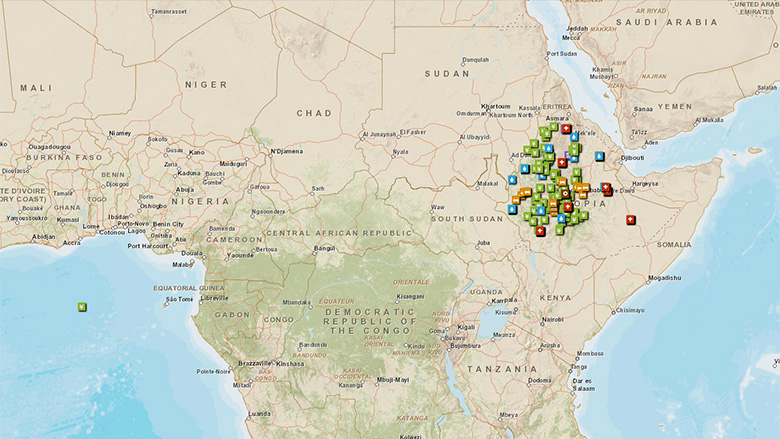In recent years, Ethiopia has been one of the fastest growing economies in Africa, averaging 9.9% per year between 2004 and 2012 compared to the regional average of 5.4%. This economic growth brought with it positive trends in reducing poverty, in both urban and rural areas. In 2005, 38.7% of Ethiopians lived in extreme poverty as measured by the national poverty line, of less than US$0.6 per day today, this figure has been reduced to29.6%.
The International Development Association has helped the government of Ethiopia promote economic growth and address systemic poverty challenges across many sectors. Over the past decade, Ethiopia has registered impressive results in key human development indicators: primary school enrollments have quadrupled, child mortality has been cut in half, and the number of people with access to clean water has more than doubled.
Challenges
The main challenges for Ethiopia are to continue and accelerate the progress made in recent years toward the Millennium Development Goals (MDGs) and to address the causes of poverty among its population.
The government is already devoting a very high share of its budget to pro-poor programs and investments. Large scale donor support will continue to provide a vital contribution in the near-term to finance the levels of spending needed to meet these challenges. However, even if donor support is increased, using aid effectively will require Ethiopia to improve governance, empower local authorities, and become more accountable to its citizens.
Notwithstanding the progress in critical aspects of human development, Ethiopia also needs considerable investment and improved policies to achieve some of the MDGs by 2015, given the country’s low starting point.
Approach
The Bank’s Country Partnership Strategy FY13-FY16 (CPS) aims to help the Government of Ethiopia achieve a stable macroeconomic environment; increase agricultural productivity and marketing in selected areas; increase competitiveness in manufacturing and services, improve its infrastructure, improve the delivery of social services and develop a comprehensive approach to social protection and risk management. IDA will also assist the GoE to improve public service performance management and responsiveness; enhance the space for citizen participation in the development process as well as its public financial management and procurement systems.
Results
Education: IDA’s support for the education sector—including through the General Education Quality Improvement Program (GEQIP) and the Protection of Basic Services project —has helped Ethiopia expand access to quality primary education over the last ten years. Total primary enrollment went from 8.1 million students attending primary school in 2001-02 to 17 million in 2011-12
Roads: Ethiopia’s development has been held back by a large infrastructure gap. IDA has invested over US$1.5 billion since 1991 to address this challenge and helped to establish a road sector development project a dedicated road fund for financing maintenance work and build capacity at many levels. IDA helped increase both the size and quality of Ethiopia’s road network from under 20,000 km of roads in 1991 to over 63,000 km in 2012.
Energy: IDA has committed close to $1.4 billion under seven active projects to support Ethiopia’s’ potential to be the electricity hub for East Africa. Assistance is also provided for exploration and production drilling activities in order to identify geothermal resources.
Partners
The International Development Association (IDA) is Ethiopia’s largest provider of development assistance. The Bank, with the United Nations Development Programme (UNDP) is one of the rotating co-chairs of the Development Assistance Group (DAG), the main forum for donor coordination in Ethiopia. The Bank has taken the lead on developing a set of multi-donor instruments to reduce transaction costs, align support with the country’s decentralized model, and enhance the predictability of aid. These instruments allow for large-scale leveraging of IDA support.
Moving Forward
Through its country partnership strategy, IDA will continue supporting the government of Ethiopia to address ongoing challenges and assist in the implementation of Ethiopia’s Growth and Transformation Plan.
Beneficiaries
Ten-year-old Senait who lives in Sele Kebele in the Oromia region is among the beneficiaries of the Protection of Basic Services Project.
“Memar ewodalehu [I love to learn!]” she says with bright eyes. Going to school has become the highlight of her life. The ‘older’ classroom she studied in lacked proper light and ventilation. She was excited to start studying in her new classroom and was eagerly awaiting the completion of the facilities there. As a nationwide program, PBS has helped improve the lives of more than 70 million rural Ethiopians: not least among them are children like Senait who now have access to services denied to them before.
Access to health services has also increased. Birhane Wolde Giorgis, 23, has worked as a Health Officer for the past year at the health center that serves the Debre Libanos woreda - consisting of about 50,000 people. On a very busy day, the health center receives as many as 40 patients. The new wing of the health center–which took five months to build with a Protection of Basic Services Project grant–provides basic maternal and childcare facilities. As a result of increased confidence in the services provided at the health center, the number of visitors has more than doubled from 200 cases per month two years ago to over 500 visitors currently.
